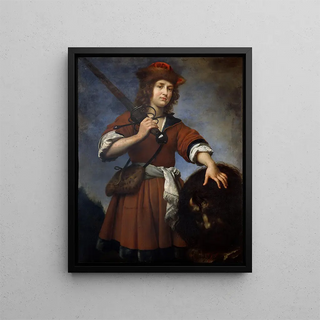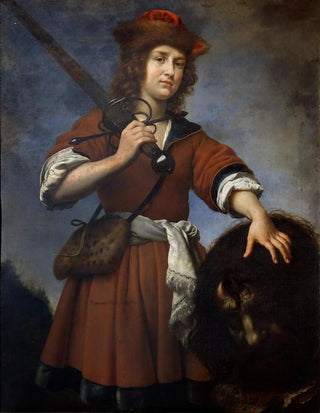Art print | David with Goliath's Head - Carlo Dolci


View from behind

Frame (optional)
Art print of David with Goliath's head - Carlo Dolci – Captivating Introduction
The "David with Goliath's head" artwork by Carlo Dolci, painted in the 17th century, embodies a moment of triumph and bravery, capturing the very essence of victory over adversity. This iconic representation of young shepherd David, holding the decapitated head of the giant Goliath, evokes a profound reflection on courage and faith. Through meticulous details and dramatic lighting, Dolci manages to convey an emotional intensity that transcends the simple biblical story. The scene, both powerful and touching, invites viewers to ponder universal themes of struggle and redemption.
Style and uniqueness of the artwork
Carlo Dolci's style is distinguished by its finesse and precision, characteristic of Italian Baroque painting. In "David with Goliath's head," every element is carefully crafted, from the textures of the clothing to the expressions on the face. Light plays a crucial role, highlighting David's features and creating a striking contrast with Goliath's shadow. This stylistic choice is not limited to realistic representation; it also evokes a spiritual dimension, where light symbolizes divine protection and inner strength. The color palette, rich and vibrant, enhances the visual impact of the composition while adding emotional depth to the artwork. Dolci's ability to capture David's moment of glory, while subtly suggesting reflection on the fragility of human life, demonstrates his artistic mastery.
The artist and his influence
Carlo Dolci, born in Florence in 1616, is often regarded as one of the masters of Italian Baroque painting. His work is marked by a constant pursuit of beauty and harmony, as well as a particular attention to detail that gives his paintings an almost spiritual dimension. Influenced by masters such as Caravaggio, Dolci developed a style that is uniquely his own, blending realism and idealization. His impact on the art of his time is undeniable, inspiring many artists across the centuries. The way he handles religious and mythological themes has also opened the

Matte finish

View from behind

Frame (optional)
Art print of David with Goliath's head - Carlo Dolci – Captivating Introduction
The "David with Goliath's head" artwork by Carlo Dolci, painted in the 17th century, embodies a moment of triumph and bravery, capturing the very essence of victory over adversity. This iconic representation of young shepherd David, holding the decapitated head of the giant Goliath, evokes a profound reflection on courage and faith. Through meticulous details and dramatic lighting, Dolci manages to convey an emotional intensity that transcends the simple biblical story. The scene, both powerful and touching, invites viewers to ponder universal themes of struggle and redemption.
Style and uniqueness of the artwork
Carlo Dolci's style is distinguished by its finesse and precision, characteristic of Italian Baroque painting. In "David with Goliath's head," every element is carefully crafted, from the textures of the clothing to the expressions on the face. Light plays a crucial role, highlighting David's features and creating a striking contrast with Goliath's shadow. This stylistic choice is not limited to realistic representation; it also evokes a spiritual dimension, where light symbolizes divine protection and inner strength. The color palette, rich and vibrant, enhances the visual impact of the composition while adding emotional depth to the artwork. Dolci's ability to capture David's moment of glory, while subtly suggesting reflection on the fragility of human life, demonstrates his artistic mastery.
The artist and his influence
Carlo Dolci, born in Florence in 1616, is often regarded as one of the masters of Italian Baroque painting. His work is marked by a constant pursuit of beauty and harmony, as well as a particular attention to detail that gives his paintings an almost spiritual dimension. Influenced by masters such as Caravaggio, Dolci developed a style that is uniquely his own, blending realism and idealization. His impact on the art of his time is undeniable, inspiring many artists across the centuries. The way he handles religious and mythological themes has also opened the






